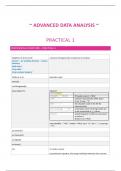Summary
samenvatting: practicum 1 + 2 (take-home assignment) - 10/10
- Course
- Institution
This summary includes practicums 1 and 2 (take home-assignment). The summary has the assignments with solutions and associated codes as well as a summary of the ppt about the practicals. I achieved 10/10 using this summary during the interim open-book exam.
[Show more]



